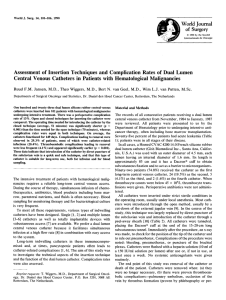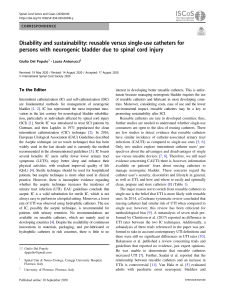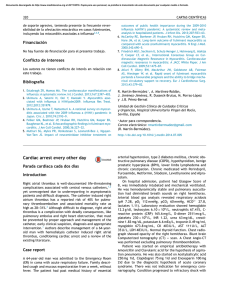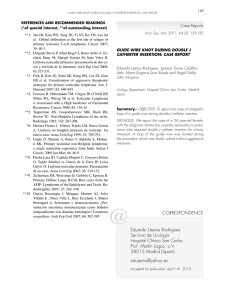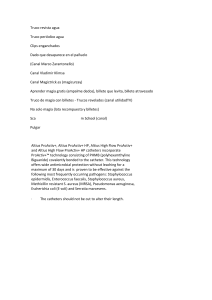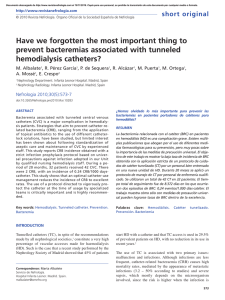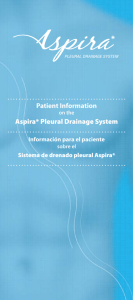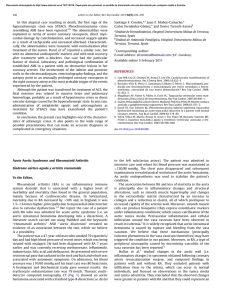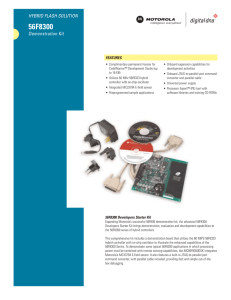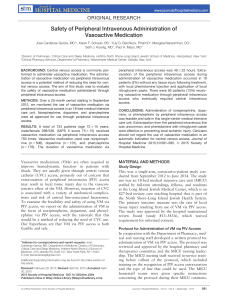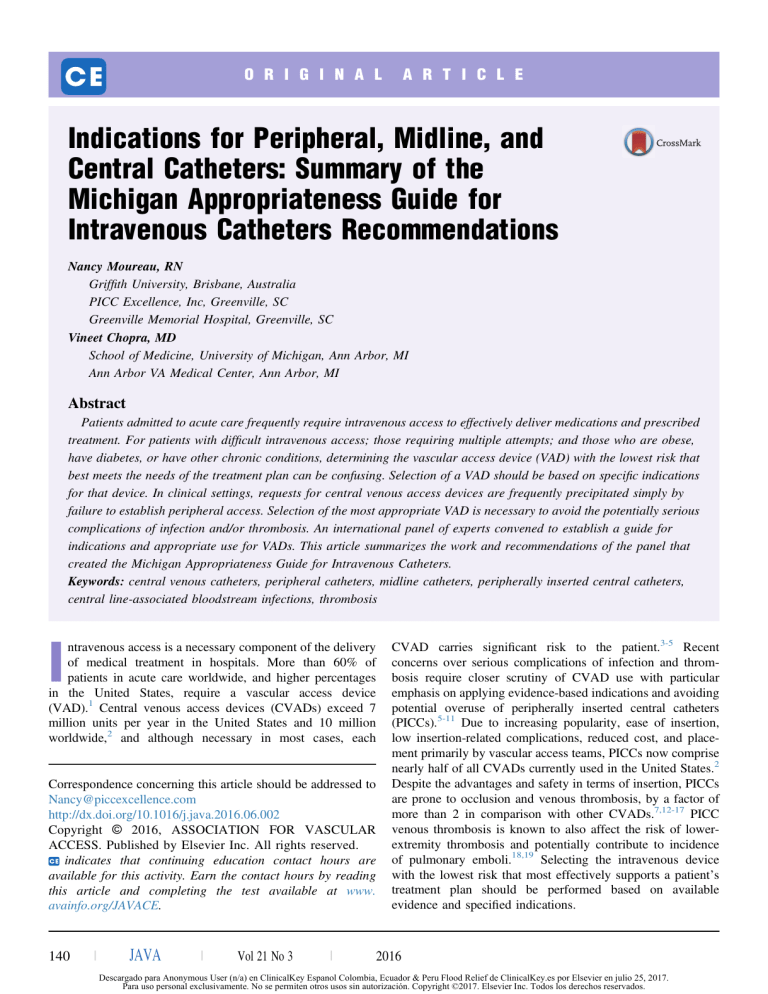
O R I G I N A L A R T I C L E Indications for Peripheral, Midline, and Central Catheters: Summary of the Michigan Appropriateness Guide for Intravenous Catheters Recommendations Nancy Moureau, RN Griffith University, Brisbane, Australia PICC Excellence, Inc, Greenville, SC Greenville Memorial Hospital, Greenville, SC Vineet Chopra, MD School of Medicine, University of Michigan, Ann Arbor, MI Ann Arbor VA Medical Center, Ann Arbor, MI Abstract Patients admitted to acute care frequently require intravenous access to effectively deliver medications and prescribed treatment. For patients with difficult intravenous access; those requiring multiple attempts; and those who are obese, have diabetes, or have other chronic conditions, determining the vascular access device (VAD) with the lowest risk that best meets the needs of the treatment plan can be confusing. Selection of a VAD should be based on specific indications for that device. In clinical settings, requests for central venous access devices are frequently precipitated simply by failure to establish peripheral access. Selection of the most appropriate VAD is necessary to avoid the potentially serious complications of infection and/or thrombosis. An international panel of experts convened to establish a guide for indications and appropriate use for VADs. This article summarizes the work and recommendations of the panel that created the Michigan Appropriateness Guide for Intravenous Catheters. Keywords: central venous catheters, peripheral catheters, midline catheters, peripherally inserted central catheters, central line-associated bloodstream infections, thrombosis I ntravenous access is a necessary component of the delivery of medical treatment in hospitals. More than 60% of patients in acute care worldwide, and higher percentages in the United States, require a vascular access device (VAD).1 Central venous access devices (CVADs) exceed 7 million units per year in the United States and 10 million worldwide,2 and although necessary in most cases, each Correspondence concerning this article should be addressed to Nancy@piccexcellence.com http://dx.doi.org/10.1016/j.java.2016.06.002 Copyright © 2016, ASSOCIATION FOR VASCULAR ACCESS. Published by Elsevier Inc. All rights reserved. indicates that continuing education contact hours are available for this activity. Earn the contact hours by reading this article and completing the test available at www. avainfo.org/JAVACE. 140 j JAVA j Vol 21 No 3 j CVAD carries significant risk to the patient.3-5 Recent concerns over serious complications of infection and thrombosis require closer scrutiny of CVAD use with particular emphasis on applying evidence-based indications and avoiding potential overuse of peripherally inserted central catheters (PICCs).5-11 Due to increasing popularity, ease of insertion, low insertion-related complications, reduced cost, and placement primarily by vascular access teams, PICCs now comprise nearly half of all CVADs currently used in the United States.2 Despite the advantages and safety in terms of insertion, PICCs are prone to occlusion and venous thrombosis, by a factor of more than 2 in comparison with other CVADs.7,12-17 PICC venous thrombosis is known to also affect the risk of lowerextremity thrombosis and potentially contribute to incidence of pulmonary emboli.18,19 Selecting the intravenous device with the lowest risk that most effectively supports a patient’s treatment plan should be performed based on available evidence and specified indications. 2016 Descargado para Anonymous User (n/a) en ClinicalKey Espanol Colombia, Ecuador & Peru Flood Relief de ClinicalKey.es por Elsevier en julio 25, 2017. Para uso personal exclusivamente. No se permiten otros usos sin autorización. Copyright ©2017. Elsevier Inc. Todos los derechos reservados. Method Recognizing the need to establish evidence-based indications for intravascular devices and specifically PICCs, an international group of expert physicians and clinicians, and 1 patient was selected to work together as part of a University of Michigan/Society of Hospital Medicine-funded initiative. In this initiative, the RAND/UCLA Appropriateness Method20 was applied to develop criteria for the selection of the best VAD for each patient. A systematic literature review was performed and disseminated to the 15-member panel for evaluation, along with 665 patient scenarios. To determine the effect on clinical decision making, devicesdincluding peripheral intravenous catheters, ultrasound-guided peripheral intravenous catheters, midline catheters, nontunneled central venous catheters (CVCs), tunneled CVCs, and portsdwere compared with PICCs. Additionally, scenarios evaluating the appropriateness of individual devices were also created. Each scenario was rated based on appropriateness of PICC or other VAD use. The RAND/UCLA Appropriateness Method incorporated information synthesis, panelist selection, patient scenarios, a rating process, and analysis of results all specific to VADs. Results The results of the review by the Michigan Appropriateness Guide for Intravenous Catheters (MAGIC) panel included ratings from 391 unique indications of appropriateness or inappropriateness for PICCs and other VADs with 2 rounds of in-person rating scenarios by the panel.21 The final results established 38% of these indications as appropriate, 43% as inappropriate, and 19% as neutral or uncertain for the 665 scenarios. Details for each device are summarized in the following sections. Peripheral Access Peripheral catheters (eg, peripheral intravenous lines and ultrasound-guided peripheral intravenous lines) establish access into the veins and arteries of the arms and, less frequently, legs or other pediatric or neonatal applications of the scalp.22,23 They are inserted using a direct visual approach or with visualization devices such as infrared or ultrasound technology. Peripheral access is considered less invasive than central access and has a lower risk of infection (0.5/ 1000 catheter-days).6,24 Peripheral catheters are considered appropriate for treatment of peripherally compatible medications and solutions (< 900 mOsm/L, not vesicant or irritant) when the duration of treatment is 6 days (Table 1) with transition to midline or PICC when duration is extended.25,26 When multiple peripheral catheter attempts fail, the designation of difficult intravenous access (DIVA) may lead to assessment and access with ultrasound or other forms of visualization technology (Figure 1). Success is enhanced with deeper ultrasound-guided access and the use of longer peripheral catheters.27-30 For all patients considered DIVAs, those with 1 failed attempts, inability to identify veins visually, or with a history of difficult access, use of ultrasound or other visual technologies is recommended to help obtain the Table 1. Peripheral Catheter Indications d d d d Peripheral intravenous catheter treatment involves the infusion of peripherally compatible solutions for 5 days or fewer Patient has adequate veins to accommodate catheter size and length Emergent use with placement in the external jugular or foot veins (emergent or < 4 d) Cyclic or episodic chemotherapy (nonvesicant) treatment for < 3 mo preferred peripheral intravenous access.26 Ultrasound-guided peripheral access, commonly inserted in the veins of the forearm, antecubital fossa, or upper arm, is indicated for treatment duration < 6 days or up to 15 days with a transition to midline catheter or PICC if treatment continues. Ultrasound-guided peripheral access is also recommended for contrast-based radiographic studies requiring upper-extremity veins with larger catheters (ie, 20-16 gauge), where visible veins to accommodate the size are not available (Table 2). Evidence supports greater success with ultrasound-guided peripheral catheter access after training.31 Greater success with these procedures results in reduced need and avoidance of CVADs.32-34 Current research and guidelines support maintaining peripheral catheters until no longer clinically indicated or until a complication develops.22,35-39 Insertion of peripheral catheters into external jugular or leg veins is considered appropriate in emergent situations with verified inserter training before the insertion and treatment is prescribed for 4 days or fewer.21 Peripheral catheters in the hand or distal portion of the upper extremity are the preferred choice when chronic kidney disease is present and glomerular filtration rate is < 44 mL/mindstage 3b or greaterdwith a focus on preserving peripheral and central veins for hemodialysis, fistula, or grafts.21 Figure 1. Ultrasound-guided peripheral catheter in the forearm (used with permission from PICC Excellence, Inc). 2016 j Vol 21 No 3 j JAVA j Descargado para Anonymous User (n/a) en ClinicalKey Espanol Colombia, Ecuador & Peru Flood Relief de ClinicalKey.es por Elsevier en julio 25, 2017. Para uso personal exclusivamente. No se permiten otros usos sin autorización. Copyright ©2017. Elsevier Inc. Todos los derechos reservados. 141 Table 2. Ultrasound-Guided Peripheral Catheter Indications d d d Use visualization technology to establish peripheral access using longer catheters for the purpose of intravenous treatment < 5 d or > 15 d (with transition to midline or peripherally inserted central catheter) For patients with 1failed attempts, inability to identify veins visually or those identified as difficult intravenous access commonly inserted in the forearm, antecubital fossa, or upper arm For contrast-based radiological studies requiring upper extremity access in larger veins with 20-, 18- or 16gauge catheter (where visible veins to accommodate catheter size are not present) Peripheral catheters are the preferred access for all patients where no indication is present for central venous access.21 Increasing clinical skill with vein selection and access through the use of ultrasound and other visual aids facilitates the goal of avoiding CVADs when no indication exists for these devices. Many hospitals have incorporated vascular access teams to insert and maintain both peripheral and central catheters with positive outcomes.40 The added expertise and skill of these team members supports the longer use of peripheral catheters. Midline Catheters Midline catheters are experiencing a resurgence of attention with great use due to improvements in catheter materials and products. The 2 most recent midline catheters are 8-10 cm in length and require the insertion technique referred to as accelerated Seldinger (Access Scientific, Bard Access Systems, Teleflex). These all-in-1 modified Seldinger technique devices with the have the needle, wire, and introducer in a combined unit for ease and speed in gaining access. The evidence supporting midline catheters is growing with a variety of publications demonstrating positive outcomes.41-48 Midline catheters have lower phlebitis rates than peripheral catheters and lower rates of infection than other central catheters. Midline catheters are considered appropriate for patients with peripherally compatible solutions or medications where treatment will likely exceed 6 days. Midline catheters are preferred for patients requiring infusions up to 14 days, but may be used in a manner consistent with the clinically indicated removal of peripheral catheters (Table 3).47,49 When patients are considered DIVAs and ultrasound-guided peripheral access Figure 2. Midline for patient with difficult intravenous access (used with permission from Matthew Ostroff). has failed, midline catheters are preferred (Figure 2). As with all vascular access devices, single lumen midline catheters are placed unless a specific indication for dual lumen is needed (only single and dual-lumen midlines are currently available). PICCs PICCs have provided a reliable bridge between shorter peripheral catheters and chest-inserted CVCs for > 20 years (Figure 3). There is reduced risk of pneumothorax, hemothorax, nerve damage, stenosis, and other more serious Table 3. Midline Catheter Indications d d d d Treatment involves peripherally appropriate solutions that will likely exceed 6 d Preferred for patients requiring infusions of up to 14 d Patients with difficult intravenous access despite ultrasound-guided peripheral catheter attempts Single-lumen midline is placed unless specific indication for dual lumen with compatible infusions 142 j JAVA j Vol 21 No 3 j Figure 3. Peripherally inserted central catheter (PICC) (used with permission from PICC Excellence, Inc). 2016 Descargado para Anonymous User (n/a) en ClinicalKey Espanol Colombia, Ecuador & Peru Flood Relief de ClinicalKey.es por Elsevier en julio 25, 2017. Para uso personal exclusivamente. No se permiten otros usos sin autorización. Copyright ©2017. Elsevier Inc. Todos los derechos reservados. Table 4. Peripherally Inserted Central Catheter (PICC) Indications d d d d d d d d d d d Patient requires intravenous access for longer than 14 d. For proposed treatment of 6 d ultrasound-guided or midline catheter preferred over PICC Clinically stable patient requiring intravenous therapy with peripherally incompatible solutions. Hemodynamically unstable patients where cardiac monitoring or use of vasopressors is necessary in cases < 14 d and > 15 d (central venous catheters favored over PICCs) PICC is preferred to central venous access device for critically ill patients with bleeding disorders for 14 d and those requiring 15 d of treatment For use with continuous infusions of vesicant, parenteral nutrition, chemically irritating, or nonperipherally compatible solutions for any duration. For cyclic chemotherapy with active cancer where treatment is > 3 mo. Consideration given to discontinuation of PICC when each cycle complete (peripheral catheter preferred when < 3 mo) Use with patients receiving frequent phlebotomy every 8 h or more often with duration of 6 d For burn patients where early implementation of PICC decreases risk of bacteraemia For use with chronic or lifelong access populations (eg, sickle cell, cystic fibrosis, or short gut) or those hospitalized more frequently than 6 times per year (tunneled catheter preferred) For use in patients in palliative treatment, actively dying, or in hospice requiring intravenous solutions For skilled nursing facilities when duration of treatment is > 14 d Prior nephrology approval if glomerular filtration rate < 30 or creatinine > 2.0 Single-lumen PICCs preferred unless specific indication for additional lumen. Use smaller-gauge PICC with fewer lumen to reduce risk of deep vein thrombosis.16,68 Measure vein size to establish appropriate catheter size < 45% of vein diameter.58 Position of terminal tip of PICC in lower third of the superior vena cava, cavoatrial junction, or right atrium CVAD-related complications with PICC placement. Indications for PICCs (Table 4) include any patient requiring peripherally incompatible infusions or for intravenous treatment lasting more than 14 days.21 Expanded nursing roles support safe placement of PICCs by specially trained teams of nurses.50-52 Increased awareness of PICCs has reduced the number of other CVAD placements. Bedside nurses are more likely to request a PICC order after having difficulty establishing peripheral access rather than considering all options and appropriateness of central access.53-55 With rising concerns over the incidence of thrombosis with PICCs and the relationship of thrombosis to infection, closer evaluation of each PICC request is necessary to evaluate the need for central vs peripheral access for each patient.21,56 Measuring the vein diameter and choosing a catheter-to-vein ratio of 45% or less may reduce thrombosis risk in PICCs and midline catheters.26,57,58 Use of antimicrobial PICCs may reduce risk and was statistically significant in reducing the level of infection by a factor of 4 in the hospital study conducted by Rutkoff.59 In Tables 4 and 5 a list of appropriate and inappropriate indications for PICCs is provided based on MAGIC.21 Nontunneled CVCs Nontunneled CVCs are commonly used for internal jugular access with acute-care patients who are unstable and who require hemodynamic monitoring or large fluid infusions. These percutaneously inserted catheters have a rate of infection Table 5. Inappropriate Peripherally Inserted Central Catheter (PICC) d d d d d d d d d d d d Placement of PICC for any noncentral indication Insertion of a PICC primarily for the purpose of establishing intravenous access when the duration of treatment is unknown Use with any infusion other than nonperipherally compatible infusates Placement of a PICC with confirmed PICC-related bloodstream infection without documented clearance of infection (line-free interval of 48-72 h with negative blood cultures) Avoid PICC use for inappropriate indications, or for patients with history of thrombosis, hypercoagulability, or decreased venous flow to extremities; consider alternative devices and remove PICC when no longer needed For renal failure stage 3b or greater chronic kidney disease with glomerular filtration rate < 44 mL/min or for patients currently receiving any renal replacement therapy Insertion for infrequent phlebotomy, < 3 times daily Medical, nursing, or patient/family request without central indication, actively dying/hospice, or other appropriate criteria for PICC Urgent request for PICC for a hemodynamically unstable or critical patient Placement of PICC on the basis of arm dominance Removal or replacement of PICC that is clinically necessary without evidence of bloodstream infection or other complication Advancement of PICC or other dislodged vascular access device in the case of migration of the catheter 2016 j Vol 21 No 3 j JAVA j Descargado para Anonymous User (n/a) en ClinicalKey Espanol Colombia, Ecuador & Peru Flood Relief de ClinicalKey.es por Elsevier en julio 25, 2017. Para uso personal exclusivamente. No se permiten otros usos sin autorización. Copyright ©2017. Elsevier Inc. Todos los derechos reservados. 143 Table 6. Nontunneled Catheter Indications d d d d Table 8. Totally Implanted Subcutaneous Port Indications Unstable patients requiring hemodynamic monitoring, multiple medications, large fluid infusions, blood or blood products, or continuous parenteral nutrition Short-term critical access. Nontunneled CVCs are preferred over PICCs for access up to 14 days Chemotherapy treatment anticipated for > 3 mo Antimicrobial nontunneled catheters are often used for these critical patients to reduce the risk of infection by approximately 40% d d appropriate for difficult venous access if use for 31 days or more is expected21 (Table 8). similar to PICCs6 and are used for short-term critical access. Nontunneled CVCs are preferred over PICCs when treatment is required for 14 days or fewer. To reduce risk of infection, antimicrobial nontunneled catheters are often used for these critical patients when the catheter is expected to stay in place for more than 5 days21,60-63 (Table 6). Tunneled CVCs Tunneled CVCs are inserted into internal jugular or subclavian veins with a subcutaneous tunnel commonly to the midchest region, but also other areas customized to the patient. Tunneled catheters are indicated for use with intravenous treatment of 31 days or longer, or more episodic treatment over several months. Typically, these CVADs are reserved for patients not considered candidates for a PICC due to vein size or thrombosis risk. Tunneled internal jugular catheters and small-bore catheters are preferred for patients with any level of chronic kidney disease requiring intravenous treatment for more than 15 days. PICCs and tunneled catheters are appropriate at all time intervals for infusion of irritating or chemotherapeutic medications. Tunneled catheters are recommended over multilumen PICCs when multiple or frequent infusions are required due to their lower incidence of complications21,64 (Table 7). Subcutaneously Implanted Ports With subcutaneously implanted ports, a catheter is inserted into either the internal jugular or subclavian vein and attached to a port reservoir. The port is implanted into a pocket created in a subcutaneous area on the chest (or arm as in arm ports), connected to the catheter, tested for flow, and secured with sutures or glue.21,65 Ports are appropriate for patients with expected treatment longer than 6 months. The MAGIC panelists rated ports as having neutral appropriateness for duration of treatment equal to 3-6 months. Ports may also be considered Table 7. Tunneled Catheter Indications d d d d Patients receiving treatment > 31 d Infusion of vesicant, irritant, parenteral nutrition, or chemotherapeutic agents regardless of duration Patients likely to receive cyclic or intermittent ongoing therapy > 31 d Patients with > 6 hospitalizations annually with expected duration of therapy > 15 d per hospitalization 144 j JAVA j Vol 21 No 3 j Patients with expected treatment > 6 mo (neutral rating for 3-6 mo duration of treatment) Patients requiring intermittent or cyclic infusion treatment, rather than continuous, for > 6 mo Discussion For the first time, the MAGIC document provides appropriateness ratings for specific VADs based on infusate, patient, duration, and treatment characteristics. Factors such as proposed duration of medication infusions, effects of the medication on vessels, patient condition (renal, critical, or chronic), or complications of infection were all evaluated (Figure 4), helping create clinically practical recommendations. However, recommendations for clinical appropriateness are often based on criteria that are difficult to estimate, such as duration of treatment. As emphasized by the patient panelist in the MAGIC initiative, an individualized approach is necessary in many situations. Application of the appropriateness criteria may also require adaptation to the particular care setting (ie, hospital, skilled nursing, or home environment). Factors such as reliability of the VAD are more important in skilled nursing and home environments where clinical support and expertise may be limited. Peripheral catheters and midline catheters have variable reliability outside the hospital setting. The concept of vessel health and preservation is focused not just on gaining better outcomes during a single hospitalization, but on preserving veins for future patient needs.66,67 Understanding and applying clinical research indicating the treatment, practice, or process leading to the best results for the patient is challenging for clinicians. Selection of recommendations and guidelines is often convenience and economically oriented rather than patient-focused, leading to a greater risk of complications for the patient. It is important to remember that limitations exist for the MAGIC guidance. First, not all recommendations translate to all patient populations. For instance, placement of CVCs in critically ill patients requires the availability of experienced and skilled staff to insert devices in manners that are safe from insertion complications, such as pneumothorax. This is implicitly assumed in MAGIC, but may not be so in the real world. Second, MAGIC does not address certain technologic advances, including antimicrobial-coated catheters or advanced devices, such as infrared vein finders, that may influence choice and selection of device. These limitations must be borne in mind when considering MAGIC. Technology ever advances and MAGIC should thus not be viewed as an all-encompassing document, but a living and breathing statement that changes with available evidence and practice. Third, it is unclear how best to implement recommendations from 2016 Descargado para Anonymous User (n/a) en ClinicalKey Espanol Colombia, Ecuador & Peru Flood Relief de ClinicalKey.es por Elsevier en julio 25, 2017. Para uso personal exclusivamente. No se permiten otros usos sin autorización. Copyright ©2017. Elsevier Inc. Todos los derechos reservados. Figure 4. Decision Factors for Appropriate Device Selection. MAGIC. Should these be incorporated into checklists, software-based applications, or electronic medical record systems? Who is responsible for adherence? Are there potential barriers in implementation that have not been considered? These types of challenges require careful thought and the use of implementation science to better understand what works and what does not in the real-world setting. MAGIC has succeeded in creating a practical list of indications, both appropriate and inappropriate, for VAD use (Table 9). This document guides physicians, bedside clinicians, and those on vascular access teams to the most appropriate selection of the safest device and practices for patients. Thomas Vesely, MD, a fellow clinician who spoke to the authors, said: Table 9. Selection, Care, and Maintenance Appropriate Practices d d d d d d d d d d Evaluate a PICC or CVC order before insertion to determine optimal device choice Exchange PICC to change device features (number of lumen) or to correctly position catheter Verify tip position via chest radiography, fluoroscopy, or electrocardiography guidance (after training and technical proficiency is confirmed) Provide > 3 mo uninterrupted systemic anticoagulation for treatment of PICC-related deep vein thrombosis in the absence of contraindications. Do not remove a functional catheter unless no longer needed or worsening symptoms persist after > 72 h of anticoagulation. PICCs of the smallest-sized catheter and appropriate vein size on the contralateral arm may be inserted with patients after deep vein thrombosis with > 3 mo of anticoagulation Provide line-free interval (48-72 h) to ensure clearance of bacteremia before insertion of CVC Removal of a CVC (eg, PICC, CVC, or tunneled catheter) after notification of physician and when catheter has not been used for any clinical purpose for 48 h or longer Removal of catheter when patient no longer has a clinical indication for use or the original use has been met Removal of catheter when used only for blood samples in stable patient when peripheral veins available Removal of catheter only by clinician trained for removal of specific device PICC ¼ Peripherally inserted central catheter; CVC ¼ Central venous catheter. 2016 j Vol 21 No 3 j JAVA j Descargado para Anonymous User (n/a) en ClinicalKey Espanol Colombia, Ecuador & Peru Flood Relief de ClinicalKey.es por Elsevier en julio 25, 2017. Para uso personal exclusivamente. No se permiten otros usos sin autorización. Copyright ©2017. Elsevier Inc. Todos los derechos reservados. 145 More than 20 nationally recognized guidelines, recommendations, and standards documents concerning vascular access were created by 10 different organizations. Insular creation of such documents is the wrong approach. It’s time that all involved agree on “the rules” even if that requires compromise and MAGIC is a good step in the right direction. More expert discussion, evaluation, and research is needed on issues where panelists failed to reach a decision, were neutral, or disagreed for VAD indications. Consistent with the variation in panelist responses, published literature often has contradictions in results from study to study. There was a paucity of the randomized controlled trials for specific VADs necessary to establish definitive conclusions. Furthermore, what works in a given setting may not work in another. Understanding how best to implement MAGIC to improve decision making in vascular access remains a key goalda goal that must be actively targeted by those in this field. d d d d Key points of MAGIC The ability to preserve vessel health for future medical needs requires clinical education and training in 3 areas: device selection, placement, and daily device care. Selection of the most appropriate VAD is necessary to avoid the potentially serious complications of infection and/or thrombosis. Selection of a CVAD should be based on indications for that specific device rather than the inability to gain peripheral access. All VADs have a risk of infection and other complications for the patient and should be removed as soon as no longer medically necessary. Conclusions Guidelines, recommendations, and standards point to the need for evidence-based indications when selecting a VAD. Relying on available literature, the combined clinical experience of the panelists, patient input, and an established methodology embodied in the RAND/UCLA Method, consensus was reached through MAGIC to establish a working guide for intravenous device indications and contraindications. Careful evaluation and application of MAGIC conclusions into the program of each facility administering intravenous treatments provides guidance toward the most appropriate and safe patient applications. In this age of electronic medical records, criteria such as MAGIC may serve as a clinical decision process embedded in the electronic medical records framework to guide clinical decisions in keeping with the theory of vessel health and preservation for patients from birth to death. Disclosures Nancy L. Moureau is a speaker and educational consultant with 3M, Access Scientific, Angiodynamics, Arrow/Teleflex, BD Carefusion, Chiesi, Cook, Entrotech, Excelsior, Fresenius Kabi, and Nexus. Vineet Chopra has no conflicts of interest to disclose. This article is jointly published with The British Journal of Nursing. 146 j JAVA j Vol 21 No 3 j References 1. Alexandrou E. One Million Global Catheters PIVC Worldwide Prevalence Study: pilot and preliminary study results. Presentation at the Annual Scientific Meeting of the Association for Vascular Access. Dallas, TX, September 25-29, 2015. 2. iData Research. U.S. market for vascular access devices and accessories. http://tinyurl.com/hmlp7mb. Accessed April 11, 2016. 3. Napalkov P, Felici DM, Chu LK, Jacobs JR, Begelman SM. Incidence of catheter-related complications in patients with central venous or hemodialysis catheters: a health care claims database analysis. BMC Cardiovasc Disord. 2013;13:86. 4. Chopra V, Flanders SA, Saint S. The problem with peripherally inserted central catheters. JAMA. 2012;308(15): 1527-1528. 5. Chopra V, Anand S, Krein SL, Chenoweth C, Saint S. Bloodstream infection, venous thrombosis, and peripherally inserted central catheters: reappraising the evidence. Am J Med. 2012;125(8):733-741. 6. Maki DG, Kluger DM, Crnich CJ. The risk of bloodstream infection in adults with different intravascular devices: a systematic review of 200 published prospective studies. Mayo Clin Proc. 2006;81(9):1159-1171. 7. Chopra V, Anand S, Hickner A, et al. Risk of venous thromboembolism associated with peripherally inserted central catheters: a systematic review and meta-analysis. Lancet. 2013;382(9889):311-325. 8. Chopra V, O’Horo JC, Rogers MAM, Maki DG, Safdar N. The risk of bloodstream infection associated with peripherally inserted central catheters compared with central venous catheters in adults: a systematic review and meta-analysis. Infect Control Hosp Epidemiol. 2013; 34(9):908-918. 9. Chopra V, Ratz D, Kuhn L, Lopus T, Chenoweth C, Krein S. PICC-associated bloodstream infections: prevalence, patterns, and predictors. Am J Med. 2014;127(4):319-328. 10. Hammes M, Desai A, Pasupneti S, et al. Central venous catheters: incidence and predictive factors of venous thrombosis. Clin Nephrol. 2015;84(1):21-28. 11. Carr PJ, Rippey JCR. Upper extremity deep vein thrombosis: a complication of an indwelling peripherally inserted central venous catheter. Clin Case Rep. 2015;3(3): 170-174. 12. Moureau N, Poole S, Murdock MA, Gray SM, Semba CP. Central venous catheters in home infusion care: outcomes analysis in 50,470 patients. J Vasc Interv Radiol. 2002; 13(10):1009-1016. 13. Evans RS, Sharp JH, Linford LH, et al. Risk of symptomatic DVT associated with peripherally inserted central catheters. Chest. 2010;138(4):803-810. 14. Saber W, Moua T, Williams EC, et al. Risk factors for catheter-related thrombosis (CRT) in cancer patients: a patient-level data (IPD) meta-analysis of clinical trials and prospective studies. J Thromb Haemost. 2011;9(2): 312-319. 2016 Descargado para Anonymous User (n/a) en ClinicalKey Espanol Colombia, Ecuador & Peru Flood Relief de ClinicalKey.es por Elsevier en julio 25, 2017. Para uso personal exclusivamente. No se permiten otros usos sin autorización. Copyright ©2017. Elsevier Inc. Todos los derechos reservados. 15. Marnejon T, Angelo D, Abu Abdou A, Gemmel D. Risk factors for upper extremity venous thrombosis associated with peripherally inserted central venous catheters. J Vasc Access. 2012;13(2):231-238. 16. Evans RS, Sharp JH, Linford LH, et al. Reduction of peripherally inserted central catheter-associated DVT. Chest. 2013;143(3):627-633. 17. Spencer FA, Emery C, Lessard D, Goldberg RJ. Worcester Venous Thromboembolism Study. Upper extremity deep vein thrombosis: a community-based perspective. Am J Med. 2007;120(8):678-684. 18. Greene MT, Flanders SA, Woller SC, Bernstein SJ, Chopra V. The association between PICC use and venous thromboembolism in upper and lower extremities. Am J Med. 2015;128(9):986-993.e1. 19. Kaplan D, Casper TC, Elliott CG, et al. VTE incidence and risk factors in patients with severe sepsis and septic shock. Chest. 2015;148(5):1224-1230. 20. Fitch K, Bernstein SJ, Aguilar MD, et al. The RAND/ UCLA appropriateness method user’s manual. http:// tinyurl.com/z84dpl4. Accessed April 5, 2016. 21. Chopra V, Flanders SA, Saint S, et al. The Michigan Appropriateness Guide for Intravenous Catheters (MAGIC): results from a multispecialty panel using the RAND/UCLA appropriateness method. Ann Intern Med. 2015;163(6 Suppl):S1-S40. 22. Rickard CM, Webster J, Wallis MC, et al. Routine versus clinically indicated replacement of peripheral intravenous catheters: a randomised controlled equivalence trial. Lancet. 2012;380(9847):1066-1074. 23. McCay AS, Elliott EC, Walden M. PICC placement in the neonate. N Engl J Med. 2014;370(11):e17. 24. Hadaway L. Short peripheral intravenous catheters and infections. J Infus Nurs. 2012;35(4):230-240. 25. Periard D, Monney P, Waeber G, et al. Randomized controlled trial of peripherally inserted central catheters vs. peripheral catheters for middle duration in-hospital intravenous therapy. J Thromb Haemost. 2008;6(8):1281-1288. 26. Gorski L, Hadaway L, Hagle M, McGoldrick M, Orr M, Doellman D. Infusion Therapy Standards of Practice. J Infus Nurs. 2016;39(1 Suppl):159. 27. Chinnock B, Thornton S, Hendey GW. Predictors of success in nurse-performed ultrasound-guided cannulation. J Emerg Med. 2007;33(4):401-405. 28. Elia F, Ferrari G, Molino P, et al. Standard-length catheters vs long catheters in ultrasound-guided peripheral vein cannulation. Am J Emerg Med. 2012;30(5):712-716. 29. Liu YT, Alsaawi A, Bjornsson HM. Ultrasound-guided peripheral venous access: a systematic review of randomizedcontrolled trials. Eur J Emerg Med. 2014;21(1):18-23. 30. Stolz LA, Stolz U, Howe C, Farrell IJ, Adhikari S. Ultrasound-guided peripheral venous access: a meta-analysis and systematic review. J Vasc Access. 2015;16(4): 321-326. 31. Schoenfeld E, Boniface K, Shokoohi H. ED technicians can successfully place ultrasound-guided intravenous 32. 33. 34. 35. 36. 37. 38. 39. 40. 41. 42. 43. 44. 45. 46. 2016 catheters in patients with poor vascular access. Am J Emerg Med. 2011;29(5):496-501. Gregg SC, Murthi SB, Sisley AC, Stein DM, Scalea TM. Ultrasound-guided peripheral intravenous access in the intensive care unit. J Crit Care. 2010;25(3):514-519. Au AK, Rotte MJ, Grzybowski RJ, Ku BS, Fields JM. Decrease in central venous catheter placement due to use of ultrasound guidance for peripheral intravenous catheters. Am J Emerg Med. 2012;30(9):1950-1954. Shokoohi H, Boniface K, McCarthy M, et al. Ultrasoundguided peripheral intravenous access program is associated with a marked reduction in central venous catheter use in noncritically ill emergency department patients. Ann Emerg Med. 2013;61(2):198-203. Gorski LA, Hallock D, Kuehn SC, Morris P, Russell JM, Skala LC. Recommendations for frequency of assessment of the short peripheral catheter site. J Infus Nurs. 2012; 35(5):290-292. Loveday HP, Wilson JA, Pratt RJ, et al. epic3: National evidence-based guidelines for preventing healthcareassociated infections in NHS hospitals in England. J Hosp Infect. 2014;86(Suppl 1):S1-S70. Tuffaha HW, Rickard CM, Webster J, et al. Cost-effectiveness analysis of clinically indicated versus routine replacement of peripheral intravenous catheters. Appl Health Econ Health Policy. 2014;12(1):51-58. Wallis MC, McGrail M, Webster J, et al. Risk factors for peripheral intravenous catheter failure: a multivariate analysis of data from a randomized controlled trial. Infect Control Hosp Epidemiol. 2014;35(1):63-68. Bolton D. Clinically indicated replacement of peripheral cannulas. Br J Nurs. 2015;24(19 Suppl):S4-S12. Hawes ML. A proactive approach to combating venous depletion in the hospital setting. J Infus Nurs. 2007; 30(1):33-44. Anderson NR. Midline catheters: the middle ground of intravenous therapy administration. J Infus Nurs. 2004; 27(5):313-321. Griffiths V. Midline catheters: indications, complications and maintenance. Nurs Stand. 2007;22(11):48-57. Alexandrou E, Ramjan LM, Spencer T, et al. The use of midline catheters in the adult acute care settingdclinical implications and recommendations for practice. J Assoc Vasc Access. 2011;16(1):35-41. Cummings M, Hearse N, McCutcheon H, Deuter K. Improving antibiotic treatment outcomes through the implementation of a midline: piloting a change in practice for cystic fibrosis patients. J Vasc Nurs. 2011;29(1):11-15. Warrington WG, Aragon Penoyer D, Kamps TA, Van Hoeck EH. Outcomes of using a modified Seldinger technique for long-term intravenous therapy in hospitalized patients with difficult venous access. J Assoc Vasc Access. 2012;17(1):24-30. Dawson RB, Moureau NL. Midline catheters: an essential tool in CLABSI reduction. http://tinyurl.com/gofyhnd. Accessed March 22, 2016. j Vol 21 No 3 j JAVA j Descargado para Anonymous User (n/a) en ClinicalKey Espanol Colombia, Ecuador & Peru Flood Relief de ClinicalKey.es por Elsevier en julio 25, 2017. Para uso personal exclusivamente. No se permiten otros usos sin autorización. Copyright ©2017. Elsevier Inc. Todos los derechos reservados. 147 47. Caparas JV, Hu J-P. Safe administration of vancomycin through a novel midline catheter: a randomized, prospective clinical trial. J Vasc Access. 2014;15(4):251-256. 48. Moureau N, Sigl G, Hill M. How to establish an effective midline program: a case study of 2 hospitals. J Assoc Vasc Access. 2015;20(3):179-188. 49. O’Grady NP, Alexander M, Burns LA, et al. Guidelines for the prevention of intravascular catheter-related infections. Am J Infect Control. 2011;39(4 Suppl 1):S1-S34. 50. Robinson MK, Mogensen KM, Grudinskas GF, Kohler S, Jacobs DO. Improved care and reduced costs for patients requiring peripherally inserted central catheters: the role of bedside ultrasound and a dedicated team. JPEN J Parenter Enteral Nutr. 2005;29(5):374-379. 51. Falkowski A. Improving the PICC insertion process. Nursing. 2006;36(2):26-27. 52. Simcock L. No going back: advantages of ultrasoundguided upper arm PICC placement. J Assoc Vasc Access. 2008;13(4):191-197. 53. Chopra V, Kuhn L, Ratz D, Flanders SA, Krein SL. Vascular nursing experience, practice knowledge, and beliefs: results from the Michigan PICC1 survey. J Hosp Med. 2016;11(4):269-275. 54. Helm RE, Klausner JD, Klemperer JD, Flint LM, Huang E. Accepted but unacceptable: peripheral IV catheter failure. J Infus Nurs. 2015;38(3):189-203. 55. Woller SC, Stevens SM, Evans RS. The Michigan Appropriateness Guide for Intravenous Catheters (MAGIC) initiative: a summary and review of peripherally inserted central catheter and venous catheter appropriate use. J Hosp Med. 2016;11(4):306-310. 56. Marschall J, Mermel LA, Fakih M, et al. Strategies to prevent central line-associated bloodstream infections in acute care hospitals: 2014 update. Infect Control Hosp Epidemiol. 2014;35(7):753-771. 57. Nifong TP, McDevitt TJ. The effect of catheter to vein ratio on blood flow rates in a simulated model of peripherally inserted central venous catheters. Chest. 2011;140(1): 48-53. 58. Sharp R, Cummings M, Fielder A, Mikocka-Walus A, Grech C, Esterman A. The catheter to vein ratio and rates of symptomatic venous thromboembolism in patients with a peripherally inserted central catheter (PICC): a prospective cohort study. Int J Nurs Stud. 2015;52(3):677-685. 148 j JAVA j Vol 21 No 3 j 59. Rutkoff GS. The influence of an antimicrobial peripherally inserted central catheter on central line-associated bloodstream infections in a hospital environment. J Assoc Vasc Access. 2014;19(3):172-179. 60. Hockenhull JC, Dwan K, Boland A, et al. The clinical effectiveness and cost-effectiveness of central venous catheters treated with anti-infective agents in preventing bloodstream infections: a systematic review and economic evaluation. Health Technol Assess. 2008;12(12):iii-iv, xixii, 1-154. 61. Pittiruti M, Hamilton H, Biffi R, MacFie J. Pertkiewicz M for ESPEN. ESPEN Guidelines on Parenteral Nutrition: central venous catheters (access, care, diagnosis and therapy of complications). Clin Nutr. 2009;28(4): 365-377. 62. Lai NM, Chaiyakunapruk N, Lai NA, O’Riordan E, Pau WSC, Saint S. Catheter impregnation, coating or bonding for reducing central venous catheter-related infections in adults. Cochrane Database Syst Rev. 2013;6: CD007878. 63. Lorente L, Lecuona M, Jiménez A, et al. Chlorhexidinesilver sulfadiazine- or rifampicin-miconazole-impregnated venous catheters decrease the risk of catheter-related bloodstream infection similarly. Am J Infect Control. 2016;44(1):50-53. 64. Tran H, Arellano M, Chamsuddin A, et al. Deep venous thromboses in patients with hematological malignancies after peripherally inserted central venous catheters. Leuk Lymphoma. 2010;51(8):1473-1477. 65. Simonova G, Rickard CM, Dunster KR, Smyth DJ, McMillan D, Fraser JF. Cyanoacrylate tissue adhesivesd effective securement technique for intravascular catheters: in vitro testing of safety and feasibility. Anaesth Intensive Care. 2012;40(3):460-466. 66. Hallam C, Weston V, Denton A, et al. Development of the UK Vessel Health and Preservation (VHP) framework: a multiorganisational collaborative. J Infect Prev. 2016;17(2):65-72. 67. Moureau NL, Trick N, Nifong T, et al. Vessel health and preservation (Part 1): a new evidence-based approach to vascular access selection and management. J Vasc Access. 2012;l13(3):351-356. 68. Grove JR, Pevec WC. Venous thrombosis related to peripherally inserted central catheters. J Vasc Interv Radiol. 2000;11(7):837-840. 2016 Descargado para Anonymous User (n/a) en ClinicalKey Espanol Colombia, Ecuador & Peru Flood Relief de ClinicalKey.es por Elsevier en julio 25, 2017. Para uso personal exclusivamente. No se permiten otros usos sin autorización. Copyright ©2017. Elsevier Inc. Todos los derechos reservados.


